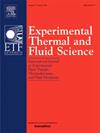Evaluation of surge propagation and discharge calculation in a sloping circular pipe
IF 2.8
2区 工程技术
Q2 ENGINEERING, MECHANICAL
Experimental Thermal and Fluid Science
Pub Date : 2025-01-15
DOI:10.1016/j.expthermflusci.2025.111409
引用次数: 0
Abstract
The generation and propagation of a positive surge in a sloping circular pipe were studied. Using a lab-scale model, positive surges were generated by rapidly closing a downstream gate, and the resulting flow patterns and surge propagation speeds were observed. The continuity and momentum equations were applied to derive an analytical solution for back-calculating discharge from measured surge speeds and hydraulic conditions. Experimental results showed the surge speed decreased with propagation distance, stabilizing beyond certain distances. The sequent depth ratio for positive surges was investigated, and the results showed that the sequent depth ratio for circular pipes was lower compared to that in a rectangular channel with the same Froude number. An equation was developed to evaluate the sequent depth ratio for positive surges in partially filled flow within a circular pipe. In practical applications, it is necessary to measure the initial water depth, the surge propagation distance, the average speed of the surge corresponding to this distance, and the water depth behind the surge wave front to estimate the discharge in the pipe. The results indicated that a longer observation distance from the disturbance location leads to a smaller error between the calculated and measured discharges, which is generally less than 10 % at measurement locations farther than 3 times the diameter length from the tailgate. Therefore, the proposed discharge calculation equation can be applied in sewer systems as an initial discharge estimation method for quick reference.
斜圆管内浪涌传播评价及流量计算
研究了正浪涌在倾斜圆管内的产生和传播。使用实验室规模的模型,快速关闭下游闸门产生正浪涌,并观察由此产生的流动模式和浪涌传播速度。利用连续方程和动量方程,推导出了由测量的浪涌速度和水力条件反演流量的解析解。实验结果表明,浪涌速度随传播距离的增加而减小,超过一定距离后趋于稳定。研究了正浪涌的顺序深度比,结果表明,在相同的弗劳德数下,圆形管道的顺序深度比小于矩形通道。建立了圆管内部分填充流中正浪涌的顺序深度比方程。在实际应用中,需要测量初始水深、浪涌传播距离、该距离对应的浪涌平均速度以及浪涌波前后的水深来估计管道内的流量。结果表明,距离扰动点越远,计算值与实测值之间的误差越小,在距离尾板直径长度3倍以上的测量点误差一般小于10%。因此,所提出的流量计算方程可作为污水系统初始流量估算方法,供快速参考。
本文章由计算机程序翻译,如有差异,请以英文原文为准。
求助全文
约1分钟内获得全文
求助全文
来源期刊

Experimental Thermal and Fluid Science
工程技术-工程:机械
CiteScore
6.70
自引率
3.10%
发文量
159
审稿时长
34 days
期刊介绍:
Experimental Thermal and Fluid Science provides a forum for research emphasizing experimental work that enhances fundamental understanding of heat transfer, thermodynamics, and fluid mechanics. In addition to the principal areas of research, the journal covers research results in related fields, including combined heat and mass transfer, flows with phase transition, micro- and nano-scale systems, multiphase flow, combustion, radiative transfer, porous media, cryogenics, turbulence, and novel experimental techniques.
 求助内容:
求助内容: 应助结果提醒方式:
应助结果提醒方式:


